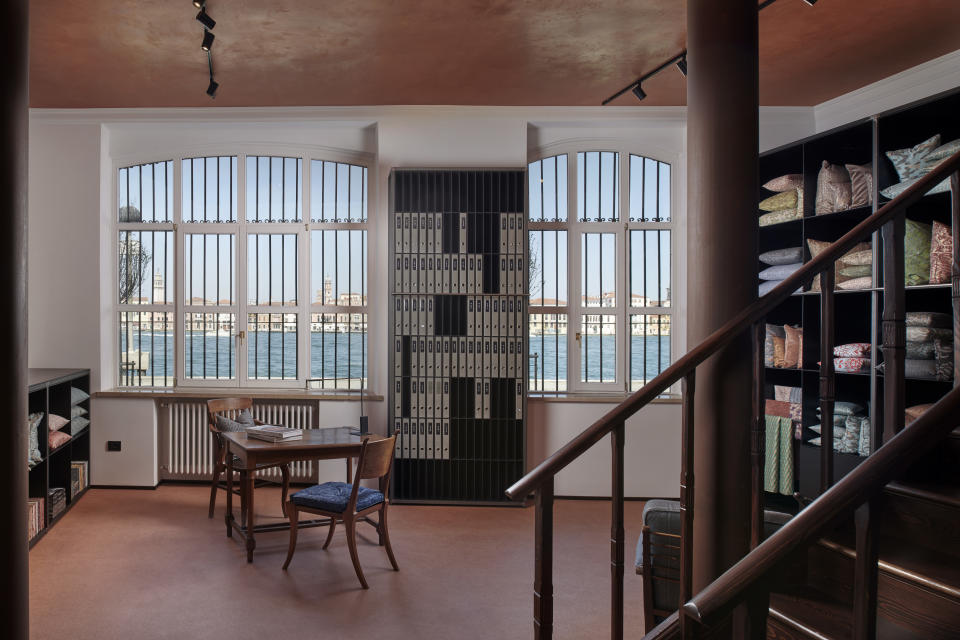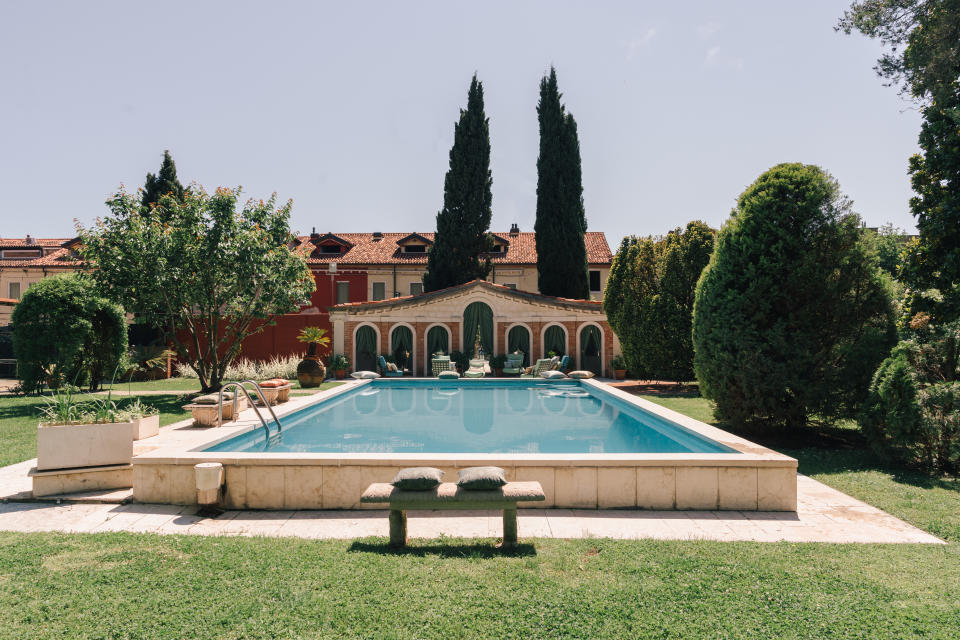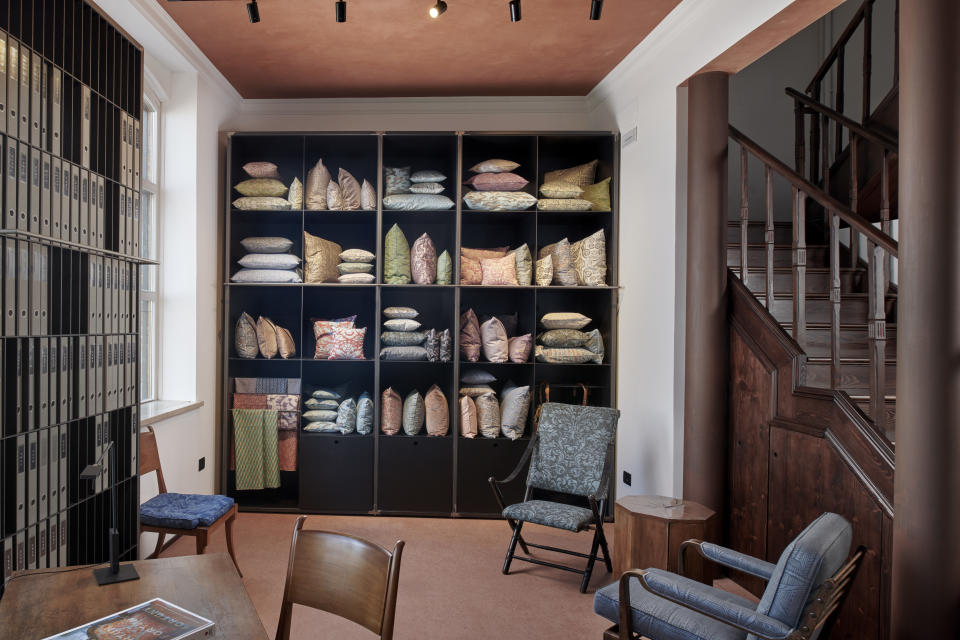Owners of Fortuny Plan Development of Storied Brand

VENICE — “The world does not need more stuff, it needs more beauty,” according to Mickey Riad, creative director of Fortuny.
The young artist and photographer, who owns the storied brand with his brother and chief executive officer Maury, is spearheading the development of Fortuny, and on Thursday he introduced the new artistic director of the label — architect Alberto Torsello, who conceived the blueprint of the new showroom, which was unveiled that day.
More from WWD
Mariano Fortuny revolutionized the worlds of textiles, fashion and the theater, said Riad, and he believes the brand stands for “the art of living, and it’s too narrow to look at only one aspect of his legacy. With Alberto, we want to express the values of the company but we must prioritize and not try to do everything at the same time, but what makes the most sense.”
The showroom is located on the Giudecca island in the storied building that also houses the factory set up by the Spanish artist, set designer and inventor Mariano Fortuny in 1922. The manufacturing plant is still active and produces around 25,000 meters of fabrics a year — deemed appropriate by Torsello for the artisanal and luxury positioning of the brand.
Torsello, who received the prestigious Compasso d’oro design award in 2018, has restored such famed buildings as the Palazzo Ducale, il Fondaco dei Tedeschi, and the Scuola Grande della Misericordia in Venice.
The Riad brothers have been leading the company since 1998, when they inherited it from their father, Maged. The latter had bought it from Elsie McNeill Lee, the interior designer who Mariano Fortuny had designated as his single representative in the U.S.
The Riads have been busy strengthening the company for its next chapter. “Fortuny deserves to be here forever, to reflect the importance of the artist that revolutionized the world of fabrics, textiles, lighting and the theater. His remarkable contributions touched the world, people know of his influence even if they don’t know him,” Mickey Riad contended.

Photo: Colin Dutton
Riad said he has been looking into developing an apparel collection, “hopefully next year.” He admitted he is “very interested in fashion,” and underscored how Fortuny had “ a voice” and “created timeless” garments that are still modern today.
Riad is based in New York, where he has a Fortuny archive, but spends six months a year in Venice. He said that in 2018 he produced prints for Rick Owens, who also lives in Venice and has often cited Mariano Fortuny as an influence. Fortuny’s first printed fabric dates back to 1922, so next year it will mark its centenary.
With a laugh, Riad did not deny the challenges Venice poses in terms of costs and practical operations, but he underscored the influence of the arts and culture of the city, “where the East and the West meet.”
Torsello shares this love for Venice, Riad underscored, praising the architect’s attention to detail and “the way he looks at the world. Everything has meaning and purpose.” In fact, in creating the showroom, Torsello opted for a “functional not merely decorative” space, explained the Venetian architect, while adding a “theatrical element with fabrics being pulled down from the ceiling as stage curtains and opening up like a flower, giving an entirely new mood to the room.”
Oak columns and floors in magnesite, a majestic wood staircase and a pillow library are some of the distinguishing elements of the showroom, in the red-brick building that encloses a beautiful and unexpected garden.

courtesy image
The fabrics are realized entirely in cotton thanks to secret techniques and by using the same original machines invented by Mariano Fortuny. The colors are created with the formulas his wife Henriette Negrin invented with natural materials, plant extracts and insects, leading for example to the unique Fortuny green. The patterns of the fabrics are inspired by the light and the reflections of the Venice lagoon.
The company does not work with stock, fabrics must be ordered and are delivered in around three months, retailing at between 300 and 450 euros a meter. Appointments to visit the showroom must be booked in advance.
The U.S. is Fortuny’s biggest market, accounting for 70 percent of business, with Europe making up the remaining 30 percent. Riad credited McNeill Lee with developing the American market, “bringing Fortuny out of the churches and museums and into the homes, selling not only by commission but also by the meter.”
Torsello said that he also wanted to help Riad “be associated with Fortuny’s artistic path, create humanistic and scientific content,” and to work with the Venice Biennale, the Guggenheim and Fortuny museums and other educational institutions, creating relations with the city and stimulating cultural exchange. “This is an artisanal activity, not industrial,” he highlighted. At the same time, he said “we are identifying new products that would be in line with the identity of the brand, such as home or personal accessories, but we also considering collaborations with artists.”
Riad and Torsello said the lockdowns drove interest in home decoration and predicted a return to more opulent, layered, textured styles in Europe, “something that never went away in the U.S. and the U.K.”
“These are not inanimate fabrics, to put soul into immaterial objects and give life to them, that is true luxury,” said Riad.

Photo: Colin Dutton
Sign up for WWD's Newsletter. For the latest news, follow us on Twitter, Facebook, and Instagram.

 Yahoo Finance
Yahoo Finance 